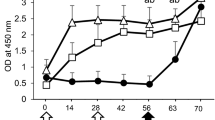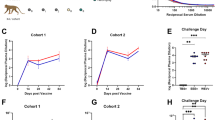Summary
Wild type Eastern equine encephalitis virus (E) was compared with a mutant (Em) derived from it. The latter was tested as an attenuated vaccine in mice. They differed in the following properties: Em formed smaller plaques on chick embryo (CE) cell monolayers and, unlike E, did not plaque on mouse embryo (ME) monolayers. Further, Em had a longer latent period and attained a lower peak titer than E after infection of CE cells, was more sensitive than E to chick interferon, and was less virulent for mice (SC and IP routes) and hamsters (IP route) than E. Both viruses were similar in several other properties tested.
The mutant was found to induce a gradient in the specificity of protection in mice against challenge by selected viruses after a single subcutaneous injection of living virus. The protection was best against autologous (Em) challenge, was next best against challenge by the virulent parent (E) virus, but was not demonstrable against cross challenge by Venezuelan encephalitis (V) virus. Conventional hemagglutination-inhibiting (HI), complement-fixing (CF), and neutralizing (N) antibodies could not be detected in Em-immunized mice even when fresh monkey or guinea pig serum was included in N tests to provide complement and/or accessory factor(s). However, N antibodies were detected in protected mice by an indirect antiglobulin test. Passive protection by serum or ascites fluids (a. f.) was characterized by a lower but otherwise similar protection gradient like that found after active immunization with virus as described above. Interferon was not detected in the a.f. used for passive protection, nor was heterologous interference evident in Em immunized mice challenged 18 days later with vaccinia or vesicular stomatitis virus. Immunized mice that survived autologous (Em) challenge showed broadened protection against a second challenge by parent E virus, and cross protection against V virus. This typical protection was associated with the presence of HI and conventional N antibodies, except for V which showed no detectable neutralizing antibodies by either a standard or antiglobulin technique.
Similar content being viewed by others
References
Berge, T. O., I. S. Banks, andW. D. Tigertt: Attenuation of Venezuelan equme encephalomylitis virus byin vitro cultivation in guinea pig heart cells. Amer. J. Hyg.73, 209–218 (1961).
Bradish, C. J., K. Allison, andH. B. Maber: Infection, interactions, and expression of virulence by defined strains of Semliki Forest virus. J. gen. Virol.16, 359–372 (1972).
Brown, A.: Differences in maximum and minimum plaque-forming temperatures among selected group A arboviruses. Virology21, 362–372 (1963).
Brown, A., V. Elsner, E. Zebovitz, andW. P. Allen: Use of an antiglobulin plaque neutralization test among group A arboviruses. Proc. Soc. exp. Biol. (N. Y.)130, 718–722 (1969).
Burge, B. W., andE. R. Pfefferkorn: Complementation between temperature-sensitive mutants of Sindbis virus. Virology30, 214–223 (1966).
Casals, J.: Relationships among arthropod-borne animal viruses determined by cross challenge tests. Amer. J. trop. Med. Hyg.12, 587–596 (1963).
Casals, J., S. M. Buckley, andD. W. Barry: Resistance to arbovirus challenge in mice immediately after vaccination. Appl. Microbiol.25, 755–762 (1973).
Cole, F. E., Jr., andR. W. McKinney: Cross protection in hamsters immunized with group A arbovirus vaccines. Infect. and Immun.4, 37–43 (1971).
Colon, J. E., J. B. Idoine, O. M. Brand, andR. D. Costlow: Mode of action of an inhibitor from agar on growth and hemagglutination of group A arboviruses. J. Bact.90, 172–179 (1965).
Colter, J. S., J. B. Campbell, andL. R. Hatch: The pathogenicity in mice of three variants of Mengo encephalomyelitis virus. J. cell. comp. Physiol.65, 229 to 236 (1965).
Griffin, D. E., andR. T. Johnson: Cellular immune response to viral infection:In vitro studies of lymphocytes from mice infected with Sindbis virus. Cellular Immunology9, 426–434 (1973).
Grossberg, S.: The interferons and their inducers: Molecular and therapeutic considerations. New Engl. J. Med.287, 79–86 (1972).
Hammon, W. M.: In: Diagnostic Procedures for Viral and Rickettsial Infections. Chapter 6: 227–280 (Lennette andSchmidt eds.) American Public Health Assoc., New York (1969).
Hammon, W. M., S. Rohitayodhin, andJ. S. Rhim: Studies on Japanese B encephalitis virus vaccines from tissue culture. IV. Preparation and characterization of pool of attenuated OCT-541 line for human vaccine trials. J. Immunol.91, 295–305 (1963).
Hearn, H. J., Jr.: Cross-protection between Venezuelan equine encephalomyelitis and Eastern equine encephalomyelitis virus. Proc. Soc. exp. Biol. (N. Y.)107, 607–610 (1961).
Hearn, H. J., Jr., A. Brown, andF. M. Hardy: Alteration of virulence of Venezuelan equine encephalomyelitis virus after passage in L cell cultures and in mice. J. infect. Dis.108, 237–242 (1961).
Hearn, H. J., Jr., andC. T. Rainey: Cross-protection in animals infected with group A arboviruses. J. Immunol.90, 720–724 (1963).
Huang, A. S., andD. Baltimore: Defective viral particles and viral disease processes. Nature (Lond.)226, 325–327 (1970).
Jordan, G. W.: Interferon ssnsitivity of Venezuelan equine encephalomyelitis virus. Infect. Immun.7, 911–917 (1973).
Maassab, H. F., T. Francis, Jr., F. M. Davenport, A. V. Hennessey, E. Minuse, andG. Anderson: Laboratory and clinical characteristics of attenuated strains of influenza virus. Bull. Wld Hlth Org.41, 589–594 (1969).
Mika, L. A., J. E. Officer, andA. Brown: Inactivation of two Arboviruses and their associated infectious nucleic acids. J. infect. Dis.13, 195–203 (1963).
Morgan, I. M.: Influence of age on susceptibility and on immune response of mice to Eastern equine encephalomyelitis virus. J. exp. Med.74, 115–132 (1941).
Price, W. H., I. S. Thind, W. D. Leary, andA. H. El Dadah: A protective mechanism induced by live group B arboviruses independent of serum neutralizing antibodies or interferon. Amer. J. Epidem.86, 11–27 (1967).
Rabinowitz, S. G., andR. A. Proctor:In vitro study of antiviral activity of immune spleen cells in experimental Venezuelan equine encephalomyelitis infection in mice. J. Immunol.112, 1070–1077 (1974).
Reed, L. J., andH. Muench: A simple method of estimating fifty percent endpoints. Amer. J. Hyg.27, 493–497 (1938).
Schlesinger, R. W.: Interference between animal viruses. In: The Viruses 3, pp. 157–194 (Burnet andStanley, eds.). New York: Academic Press, 1959.
Schlesinger, S., M. Schlesinger, andB. W. Burge: Defective virus particles from Sindbis virus. Virology48, 615–617 (1972).
Shenk, T. E., andV. Stollar: Defective-interfering particles of Sindbis virus I. Isolation and some chemical and biological properties. Virology53, 162–173 (1973).
Theiler, M.: In: Yellow Fever (Strode, G. E., ed.), pp. 39–136. New York: McGraw-Hill, 1951.
Thind, I. S., andW. H. Price: Passive transfer of acquired resistance in mice of group B arboviruses by serum protective factor(s) (SPF) independent of serum neutralizing antibody or interferon. Amer. J. Epidem.88, 287 (1968).
Thiry, L.: Chemical mutagenesis of Newcastle disease virus. Virology19, 225–236 (1963).
Wagner, R. R., A. H. Levy, andT. J. Smith: Techniques for the study of interferons in animal virus-cell systems. In: Methods in Virology. (Maramorosch andKoprowski eds.), IV, 1–52. New York: Academic Press, 1968.
Zebovitz, E., andA. Brown: Interference among group A arboviruses. J. Virol.2, 1283–1289 (1968).
Author information
Authors and Affiliations
Additional information
With 2 Figures
Deceased (October 1974).
Rights and permissions
About this article
Cite this article
Brown, A., Officer, J.E. An attenuated variant of eastern encephalitis virus: Biological properties and protection induced in mice. Archives of Virology 47, 123–138 (1975). https://doi.org/10.1007/BF01320552
Received:
Issue Date:
DOI: https://doi.org/10.1007/BF01320552




